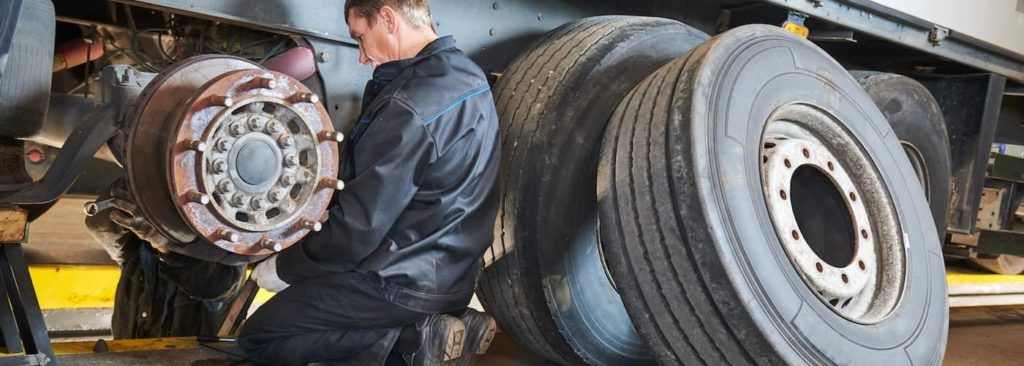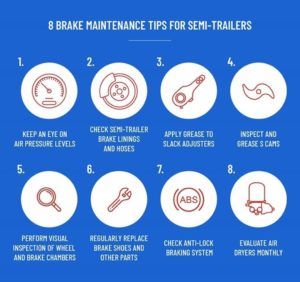
Every year the Commercial Vehicle Safety Alliance (CVSA) conducts its annual Brake Safety Week across North America. During Brake Safety Week, commercial motor vehicle inspectors emphasize the importance of brake systems by conducting inspections and removing commercial motor vehicles found to have brake-related out-of-service violations from our roadways. In addition to inspections and enforcement, law enforcement agencies will work to educate commercial motor vehicle drivers, motor carriers, mechanics, owner-operators and others on the importance of proper brake maintenance, operation and performance through outreach, education and awareness campaigns.
Last year 43,565 inspections were conducted on commercial motor vehicles during Brake Safety Week. Brake-related violations accounted for 8 out of the top 20 vehicle violations in 2020, according to results provided by the FMCSA. In addition, 12% of the CMVs inspected were placed out of service for brake-related violations.
One of the most important responsibilities semi-trailer owners and operators have is to maintain brakes that work effectively. Unfortunately, brake problems account for 29% of all large truck crashes making the consequences of inadequate brake performance potentially catastrophic. Semi-trailers traveling 65 MPH can take up to two football fields to come to a complete stop, and that is with fully functioning semi-trailer brakes. If any component of the semi-trailer air brake system is faulty, it could extend the distance needed to stop or inhibit stopping altogether.
The brakes are an essential component of any vehicle. But unlike passenger cars, semi-truck brakes are responsible for slowing down the vehicle and whatever goods the truck is hauling. that’s where brake maintenance comes into play. Check out the eight important brake maintenance tips for CMVs:

Keep an Eye on Air Pressure Levels
Truck brakes rely on adequate air pressure levels to function properly. Be sure to check your air pressure gauge before heading out on the road so you know everything is in good working condition.
Check Semi-Trailer Brake Linings and Hoses
Brake linings are an integral part of semi-trailer brakes and because of their frequent use, it’s imperative that they be checked regularly.
Apply Grease to Slack Adjusters
Whether the truck has manual or automatic slack adjusters, it’s important to remember to keep both lubricated for an effective air brake system.
Inspect and Grease S Cams
Proper lubrication will not only ensure truck brakes don’t seize, but it will also support the lifespan of your S cams. Make it a point to inspect the S cams between shoe changes and add more lubricant if necessary
Perform Visual Inspection of Wheel and Brake Chambers
Safe brakes also depend on well-maintained wheels. Performing regular wheel inspections will help prevent problems from arising. Clean wheels and examine exposed areas for damage like wear, corrosion or cracks.
Regularly Replace Brake Shoes and Other Parts
Brake drums can wear and crack from heat, so regular replacement is of utmost importance. It is recommended that you replace all interrelated brake parts at the same time.
Check Anti-Lock Braking System
While your anti-lock braking system may not require frequent maintenance, it is a good idea to check it at least once a year during your annual safety inspection. To ensure that the brakes perform at their best, never ignore ABS warning codes.
Evaluate Air Dryers Monthly
Conduct monthly evaluations of your air dryer by checking for moisture in the air brake system. If you do find moisture present, it may be time to replace the air dryer.
Why should a professional always perform brake work?
Experienced drivers might be able to perform some brake maintenance by themselves, but when it comes to brake work, it’s always a better idea to trust pros who specialize in mobile semi-truck servicing. When you take your truck to a professional, you can rest easy knowing that the brake maintenance will be performed correctly and that the brakes will function properly.
How often should brake maintenance be performed?
Your service schedule depends on the type of truck you drive and your style of driving. That said, the recommendation is to get your brakes inspected each time you get an oil change. This schedule should ensure your brakes are always in good working condition.
Some additional steps to follow to avoid brake troubles and unsafe situations:
- Conduct Routine Inspections: At the start of the day, before hitting the road, and at the end of the day, inspect your brakes using the FMCSA’s Brake Inspection Checklist. First, gather chalk for marking the push-rods, a small ruler for measuring push-rod travel and brake linings, a helper to apply the brakes as needed, and blocks/chocks for behind the tires. Go down the list and check for issues like chaffing, damaged components, worn or cracked brake pads, or cracked brake drums. When you measure push-rod travel stroke, make sure the air pressure gauges are 90 to 100 PSI.
- Complete DVIRs: This is a legal requirement in the U.S. Complete a Driver-Vehicle Inspection Report (DVIR) each time you conduct an inspection of your truck. Inspect your brakes and other crucial areas, report any issues, sign off, then immediately make any repairs as needed, such as brake pad maintenance.
- Monitor Your Driving Habits: Make sure to always travel at safe speeds and maintaining safe following distances, so if you do need to stop suddenly, the brake system won’t have to work as hard.
Educating your drivers and monitoring their driving behaviors can save your trucks’ brakes. Some tips for fleet managers to focus on are:
- Practice Preventive Care: Loop maintenance staff members into safety trainings where drivers are instructed on how to properly inspect brakes and prep them for summer or prep them for winter, as well as other vehicle components. Follow up by planning brake maintenance programs that give drivers a clear-cut inspection schedule that ensures they’re carried out regularly.
- Stress Safe Driving Behaviors: Incorporate responsible driving behaviors into safety meetings and trainings, as well as educate drivers on how brake issues can be avoided by driving with care.
- Use Telematics Data: In addition to vehicle and trailer tracking, telematics can be used to detect dangerous driving behaviors, such as hard braking or speeding. Check the data often and address instances of unsafe driving that could put the driver, others on the road, and vehicle systems at risk.
Commercial motor vehicles are very durable and high-performance vehicles, but they must be maintained to keep them working the way they should. One of the most important aspects of caring for your truck is keeping up with the brake maintenance. Keeping brakes in good condition is essential when it comes to safety, maneuvering and performance on the road.
Sources:
Hale Trailer Brake & Wheel, Feb. 9, 2021.
What You Should Know About Semi-Truck Brake Maintenance, June 10, 2021.


